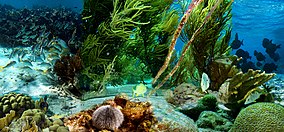Bonaire National Marine Park
| Bonaire National Marine Park | |
|---|---|
 Underwater life of Klein Bonaire. Composite of 8 photos from snorkeling on a flat coral reef off the islet Klein Bonaire. | |
| Location | Bonaire, Caribbean Netherlands |
| Nearest town | Rincon |
| Coordinates | 12°10′18″N 68°17′37″W / 12.1717°N 68.2937°W[1] |
| Area | 27 km2 (10 sq mi) |
| Established | 1979 |
| Operator | STINAPA Bonaire |
| Website | Bonaire National Marine Park |
The Bonaire National Marine Park or BNMP is one of the oldest
In 1999, the underwater park received the status of national park from the Netherlands Antilles. The uninhabited island Klein Bonaire was added to the underwater park as a legally protected nature reserve in 2001. The west side of Bonaire teems with diving sites that are easily accessible from the shore. The dive sites around Klein Bonaire are accessible by boat for divers. With the exception of a small area, the BNMP is completely open to divers with a total of 86 public dive sites.
Due to an infiltration of Stony Coral Tissue Loss Disease (SCTLD), scuba diving is currently prohibited at the dive sites located off the shores of Bonaire’s Washington Slagbaai National Park. SCTLD has also resulted in Klein Bonaire being closed to visitors in the afternoon. Signs posted at the island’s dive sites and dive shops instruct divers and snorkelers on how to sanitize their gear to help prevent the spread of SCTLD, with most dive shops offering sanitizing rinse bins. Snorkelers heading to Washington Slagbaai Park are required to stop at the ranger-run sanitizing stations just inside the park. Dive sites can close without warning, so check with your dive shop or STINAPA prior to heading out to dive. [4]
Geography

The national park covers the waters around Bonaire from the high water mark to a depth of 60 meters.[5] Also some coastal stretches with mangrove forests, for example in the lagoon Lac. Part of the park is also the uninhabited island of Klein Bonaire. The national park also contains several important wetlands, which are particularly protected under the Ramsar Convention. In general Bonaire reef ecosystem has fewer
Flora and Fauna
Open Water
The flora and fauna of the open water off the coast of Bonaire are not well researched. The water, as typical of the region, is quite warm and contains few natural nutrients, but large quantities of phytoplankton live in this area. Large fish occasionally observed in this area include tuna, wahoo, marlin and swordfish. Also whale sharks have already been spotted in the waters.[citation needed]
Seabed
At the bottom of the Bonaire National Marine Park are extensive seagrass beds, which are of the seagrass species
Coral Reefs
Bonaire is surrounded by
Lac bay
In the lagoon of Lac Bay is the only significant concentration of mangroves on Bonaire. Here grow
Tourism
Already in 1939, the famous diving pioneer Hans Hass visited Bonaire and reported in his books on the rich underwater world.[9]
Bonaire National Marine Park known as one of the hotspots for divers in the Caribbean and as one of the world's best places for snorkeling. For example,
Unique to the Bonaire National Marine Park is that it runs entirely on its own income (without
See also
References
- ^ a b Bonaire Marine Park UNESCO World Heritage Center
- ^ a b "Bonaire National Marine Park | DCNA". www.dcnanature.org. Archived from the original on 2013-08-25.
- ^ Bonaire in Bonaire, Sint Eustatius, and Saba Protected Planet
- ^ Marine Park CORAL REEFS PARK RULES BONAIRE DIVE SITES STINAPA Bonaire
- ^ a b Kalli De Meyer, Duncan MacRae Bonaire National Marine Park Management Plan 2006 STINAPA Bonaire
- ^ Flamingo Tongue Dutch Caribbean Nature Alliance
- ^ Lac MANGROVE FOREST CORAL REEF NURSERY STINAPA Bonaire
- ^ Lac Tourism Corporation Bonaire
- ^ Jung, Michael and Kalli de Meyer: Hans Hass and his Journeys to Bonaire and the History of the Bonaire Marine Park and the Development of the Diving Industry on Bonaire. Merzig, 1999
- ^ Breanna Wilson 10 Must-Dive Destinations For 2017 Forbes Media LLC
- ^ S.C. Jameson et al.,A coral damage index and its application to diving sites in the Egyptian Red Sea Coral Reefs (1999) 18, pages 333—339 Springer-Verlag.
- ^ J.A. Dixon et al. (1994) Ecology and microeconomics as joint products: the Bonaire Marine Park in the Caribbean. In: C. Perrings, et al. (eds) Biodiversity conservation: problems and politics. Kluwer Academic Press, Dordrecht
- ^ Water Sports in Bonaire Tourism Corporation Bonaire.
- ^ Dive Map STINAPA Bonaire



